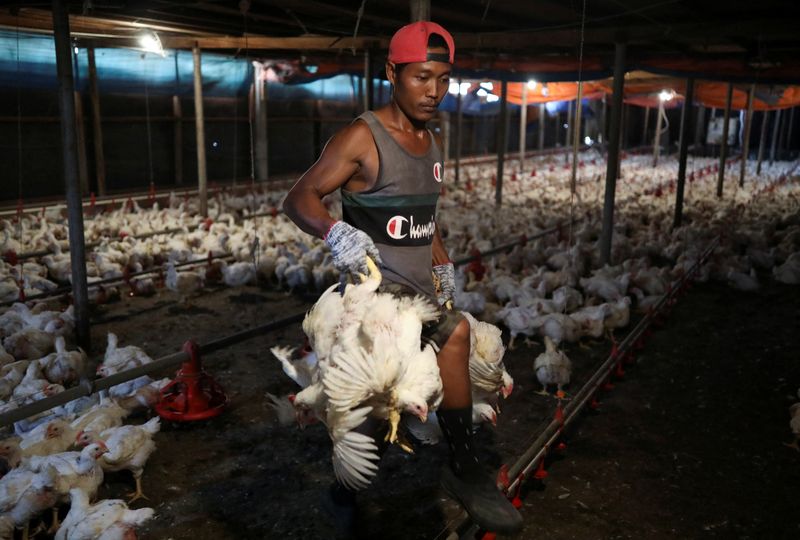By Chen Lin and Mei Mei Chu
SINGAPORE/KUALA LUMPUR (Reuters) - Singapore is bracing for a shortage of its de-facto national dish, chicken rice, as major supplier Malaysia halts all chicken exports from Wednesday.
Restaurants and street stalls in the city-state are faced with hiking prices of the staple food or shutting down altogether as their supplies dwindle from neighbouring Malaysia, where production has been disrupted by a global feed shortage.
Malaysia's export ban is the latest sign of growing global food shortages as countries, reeling from the effects of Russia's invasion of Ukraine, extreme weather, and pandemic-related supply disruptions, scramble to shore up domestic supplies and tame food inflation. (For an interactive graphic, click here: https://tmsnrt.rs/3wZqRBV)
Rising prices for basic food items have already fuelled protests in countries like Argentina, Indonesia, Greece and Iran. [L5N2XA3U7]
Daniel Tan, owner of a chain of seven stalls called OK Chicken Rice, said Malaysia's ban will be "catastrophic" for vendors like him.
"The ban would mean we are no longer able to sell. It's like McDonald's (NYSE:MCD) with no burgers," he said.
He added his stalls usually source live birds from Malaysia but will have to switch to using frozen chicken within the week and are expecting a "strong hit to sales" as customers react to the change in quality of the dish.
Singapore, although among the wealthiest countries in Asia, has a heavily urbanised land area of just 730 square km (280 square miles) and relies largely on imported food, energy and other goods. Nearly all of its chicken is imported: 34% from Malaysia, 49% from Brazil and 12% from the United States, according to data from Singapore Food Agency (SFA).
A plate of simple poached chicken and white rice cooked in broth served with a side of greens is a dish beloved by the country's 5.5 million people, and is usually widely available for about S$4 ($2.92) at eateries known as hawker centres.
The SFA has said the shortfall can be offset by frozen chicken from Brazil, and has urged consumers to opt for other protein sources like fish.
Malaysia, itself facing soaring prices, has decided to halt chicken exports until local production and costs stabilise.
Prices have been capped since February at 8.90 ringgit ($2.03) per bird and a subsidy of 729.43 million ringgit ($166 million) has been set aside for poultry farmers.
Chicken feed typically consists of grain and soybean, which Malaysia imports. But the government is having to consider alternatives amid a global feed shortage.
Lower quality feed means the birds are not growing as fast as usual, slowing down the entire supply chain, said poultry farmer Syaizul Abdullah Syamil Zulkaffly.
Previously, Syaizul's farm of broiler chicken was able to harvest as many as seven times a year, with 45,000 birds harvested per cycle. This year he expects only five harvest cycles.
Syaizul, who started feeling the pinch of higher operating costs during the pandemic, says the export ban will only make things worse for poultry farmers.
"I don't know if this industry can sustain me ... for the next five or 10 years," he said, adding that he's had to go into debt to keep up with costs.
"Maybe I should go work at a petrol station or something is even better, less headache than actually managing a chicken farm."

($1 = 1.3713 Singapore dollars)
($1 = 4.3770 ringgit)